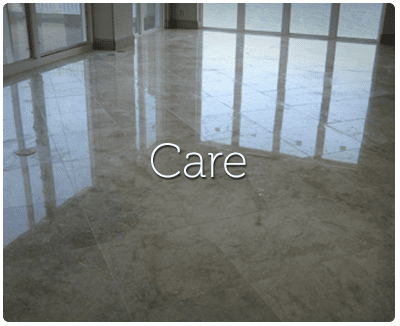Marble, limestone, granite, onyx, travertine:
Appearance
Polished natural stones like marble and granite should be very shiny, and you should be able to see the veining or fill-in a stone quite clearly. In fact, the surface should be glass-like.
Some Things to Keep In Mind
- The shinier the surface, the more you can make out the detail in the underlying stone. In some cases, this is not desirable as the stone may appear to be damaged in some way, with pits or pores both visible and tactile, when in fact, the true character of the stone is simply becoming all the more apparent.
- The shine of a stone can be measured by more than just the “eye test.” A gloss meter can actually calculate the shine on the reflective surface and give a numerical reading on a scale of zero to one hundred. A reading of 100 corresponds to a glass-like reflection. However, certain natural stone surfaces do not lend themselves well or at all to polishing. Among these are slate and soapstone. Slate is a rough, layered stone, while soapstone is more than 40% talc, and quite soft.

Examples: Marble, Limestone, Onyx, Travertine
Calcium-based stones like marble, limestone, onyx, and travertine are sensitive to substances that are not pH neutral. Your household cleaners, cosmetics, soaps, medications, and foods are generally either acidic or alkaline (basic) by nature. When these products come in contact with the marble, limestone, or other calcium-based counters, walls, or floors in your home, a chemical reaction is initiated that leaves the stone scarred.
That scarring will usually take the form of etching:
- If the surface is highly polished, there will suddenly be a dull spot, often in the shape of a cup, container, or spray pattern.
- Some of the most acidic substances to which you will expose your stone include coffee, coke, vinegar, and citrus. Contact lens solutions, hair spray, aftershave, perfume, and many other specialty cosmetics can also cause problems.
Care and Cleaning Tips
- Minimize damage by routinely cleaning your stone with a neutral pH cleaner, sealing the stone at least annually, and having the etching professionally removed periodically in the course of resealing.
- If cosmetics and soaps are usually kept on a vanity top, place them on a tray instead so that contact is minimized.
- In a shower, do the same for shampoos and soaps that normally sit directly on the seat or shelves.
- Use a squeegee to remove as much moisture from the stone walls of the shower as possible so that it is not absorbed by the stone leaving dull, stained, or etched surfaces.
Granite Care and Cleaning Tips
- Annual sealing of the granite will fill the pores of the stone with a substance that will generally reject water and other household liquids.
- Resealing is done periodically due to the evaporation of the sealer and the eventual breakdown of its solid components.
- Routine (daily) cleaning should be done with a neutral pH cleaner.
- Keeping the surface dry after use will help extend the life of the sealer as well.

